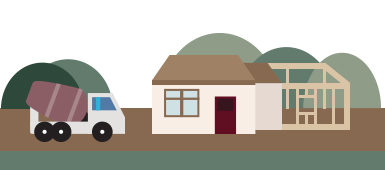The challenges
Housing and urban development: The challenges and our interest.
 Meeting the demand for housing means considering many economic and social factors and, at the individual level, people's diverse and sometimes complex circumstances.
Meeting the demand for housing means considering many economic and social factors and, at the individual level, people's diverse and sometimes complex circumstances.
Planning for urban development is more complicated than people might realise
- Building more housing and supporting the development of urban areas relies on effective and co-ordinated long-term planning.
- It is essential that agencies work together effectively to plan, fund, and implement housing initiatives and the associated infrastructure and social services.
- There has been no overriding, coherent framework for spatial planning in New Zealand (which means there is no clear “helicopter view” of how, for example, the housing developments throughout New Zealand will work with the hospital plans, the school and tertiary education plans, the road and rail plans, any plans to ensure that we have enough land to grow food, and so on).
- Planning is complicated by competing goals when decisions need to be made about zoning (which areas are for housing, for farming, and for commercial businesses), about the infrastructure to support those activities, and about environmental protection.

Availability of land at the right price
- Land prices are very high in some urban areas in New Zealand, particularly in Auckland. In our three largest cities, land and infrastructure costs are the biggest costs of residential development.
- The current system of council zoning and planning regulations, in particular the rules about building heights and housing density, constrains the supply of additional land for housing and how land already zoned for housing can be used.
- High land prices and restrictions on what type of housing can be built have made the housing market more unaffordable.
- Highly productive land has increasingly been used for housing development or lifestyle blocks. The loss of land for agriculture is often irreversible.
- There are significant tracts of land owned by iwi and hapū, but it has not been easy to get funding for developing housing on Māori land. Māori landowners need support to access funding, develop, or build to help meet community demand. The issues are different for Māori freehold land and land owned by organisations involved with post-settlement governance.

Building sector capacity and capability
- Construction costs have continued to increase, which contributes to the rising cost of houses.
- Houses cannot be built if the country does not have enough skilled workers to construct them. The capability and capacity of the building and construction sector is an important factor in determining the pace and scale of development.
- New Zealand is dominated by small firms and self-employed contractors, so our housing construction sector is not well set up to construct large numbers of houses at once. Innovative approaches are being tested but this is a difficult challenge to overcome.
- Attracting international companies to build housing here is not straightforward. The small New Zealand market has limited attraction for international firms that are large enough to build housing at the required scale and pace. Large firms tend to look for long-term commitments to justify their investment and their need to recruit and train staff.

Providing infrastructure
- The significant cost of providing infrastructure (such as roads, water and wastewater pipes, and public transport options) is a barrier to development. The cost for big projects can amount to billions of dollars.
- Infrastructure funding is a difficult balancing act for councils. They need to maintain existing infrastructure and build new infrastructure while managing debt levels, being expected to keep rates low, and still delivering the outcomes and other services that the community wants.
- The way councils are funded (through rates) affects how they approach new infrastructure development. Councils have some ways to recover costs (such as development contributions).

Next: Read about the system
